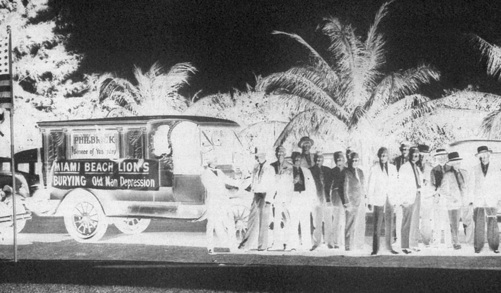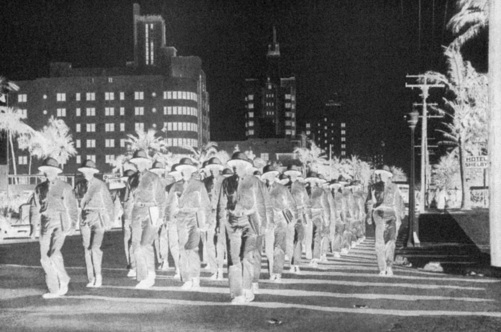The History of Florida (69 page)
Read The History of Florida Online
Authors: Michael Gannon
Tags: #History, #United States, #State & Local, #Americas

The Great Depression · 329
Marjorie Kinnan Rawlings came to Florida from Rochester, New York, in 1928. Living in
the sparsely settled scrub at Cross Creek south of Gainesville, she divided her time be-
proof
tween growing oranges and writing fiction. In several notable books, which included
South
Moon
Under
(1933);
The
Yearling
(1938), which won a Pulitzer Prize; and the au-tobiographical
Cross
Creek
(1942), she took as her subjects the proud taciturn Crackers
who eked out a bare subsistence from the fields, woods, and lakes of Florida’s half-wild
interior. In a fitting tribute, her friend and attorney Philip S. May, of Jacksonville, wrote
her in 1947: “Ponce de León discovered Florida in 1513, but he had found only the physi-
cal and material Florida. Then, more than 400 years later, you came to discover the
heart and spirit of Florida and revealed them to the world in writings of rare beauty
and sensitiveness.”
New Deal programs did not solve unemployment in Florida, nor did
they end the Great Depression. World War II did that. Yet they galvanized
Floridians and reversed the slide of economic decline. Without question the
New Deal supplied desperately needed funds, and Roosevelt’s leadership
gave Florida citizens a powerful psychological boost. The 1930s were a mas-
sive lesson in overcoming adversity. During the decade the state’s physical
contours, urban and rural, changed. A new concept of state government
responsibilities emerged, and the necessary agencies to fulfil the obligations
became fact.

330 · William W. Rogers
The Miami Beach Lions Club exhibits its optimism in the midst of the Great Depression.
Floridians sought ways to lift themselves out of their misery (hence the
popularity of Margaret Mitchel ’s novel
Gone
with
the
Wind
and the movie
that followed). Unable to afford membership in a country club, they seized
on miniature golf as a leisure-time substitute. In numerous inspiring ways
proof
they discovered that they possessed reservoirs of fortitude, strength, and
good humor. As one writer noted, the title song of Walt Disney’s cartoon
“Who’s Afraid of the Big Bad Wolf” became a metaphor for their struggle
against the Great Depression.
Notes
1.
Tal ahassee
Daily
Democrat,
18 April 1931.
2.
Annual
Report
Banking
Department
[Florida],
30 June 1931, p. 5, hereafter cited as
ARBD.
3.
Tal ahassee
Daily
Democrat,
2 February 1933.
4. Lyn Rainard, “Ready Cash on Easy Terms: Local Responses to the Depression in Lee
County,” p. 297.
5.
Jacksonvil e
Florida
Times
Union,
10 March 1933.
6.
ARBD,
30 June 1933, p. 6.
7.
Tampa
Tribune,
6 April 1936.
The Great Depression · 331
Bibliography
Buchanan, Patricia. “Miami’s Bootleg Boom.”
Tequesta
30 (1970):13–31.
Cox, Merlin G. “David Sholtz: New Deal Governor of Florida.”
Florida
Historical
Quarterly
43, no. 2 (October 1964):142–52.
Dunn, James Wil iam. “The New Deal and Florida Politics.” Ph.D. dissertation, Florida
State University, 1971.
Ginzl, David J. “The Politics of Patronage Florida Republicans during the Hoover Admin-
istration.”
Florida
Historical
Quarterly
61, no. 1 (July 1982):1–19.
Hughes, Melvin Edward, Jr. “Wil iam J. Howey and His Florida Dreams.”
Florida
Historical
Quarterly
66, no. 3 (January 1988):243–64.
Kersey, Harry A., Jr.
The
Florida
Seminoles
and
the
New
Deal,
1933–1942.
Boca Raton: Florida Atlantic University Press, 1989.
La Godna, Martin M. “Greens, Grist and Guernseys: Development of the Florida State Ag-
ricultural Marketing System.”
Florida
Historical
Quarterly
53, no. 2 (October 1974):146–
63.
Loftin, Bernadette K. “A Woman Liberated: Lil ian C. West, Editor.”
Florida
Historical
Quarterly
52, no. 4 (April 1974):396–403.
Long, Durward. “Key West and the New Deal, 1934–1936.”
Florida
Historical
Quarterly
46,
no. 3 (January 1968):209–18.
Lowry, Charles B. “The PWA in Tampa: A Case Study.”
Florida
Historical
Quarterly
52, no.
4 (April 1974):363–80.
Mardis, John. “Federal Theatre in Florida.” Ph.D. dissertation, University of Florida, 1972.
Rainard, R. Lyn. “Ready Cash on Easy Terms: Local Responses to the Depression in Lee
proof
County.”
Florida
Historical
Quarterly
64, no. 3 (January 1986):284–300.
Sewel , J. Richard. “Cross-Florida Barge Canal, 1927–1968.”
Florida
Historical
Quarterly
46,
no. 4 (April 1968):369–83.
Shofner, Jerrell H. “Roosevelt’s ‘Tree Army’: The Civilian Conservation Corps in Florida.”
Florida
Historical
Quarterly
65, no. 4 (April 1987):433–56.
Snyder, Robert E. “Marion Post and the Farm Security Administration in Florida.”
Florida
Historical
Quarterly
65, no. 4 (April 1987):457–79.
Stoesen, Alexander R. “The Senatorial Career of Claude D. Pepper.” Ph.D. dissertation,
University of North Carolina, 1965.
19
World War II
Gary R. Mormino
For a state that trafficked in hyperbole, Florida had ample reasons to wel-
come the first Sunday in December 1941. Not since the giddy days of the
mid-1920s had residents of the Sunshine State expressed such optimism.
Symbolical y, the first Sunday of December marked the official beginning
of Florida’s tourism season, but by the Sunday afternoon of December 7,
news of Pearl Harbor shattered the expectations of beaches filled with free-
spending tourists.
On the eve of Pearl Harbor, Floridians, like most Americans, were deeply
proof
divided over the questions of isolationism, neutrality, and intervention. But
as the
Tal ahassee
Democrat
editorialized: “Japan has done one thing for us.
The cowardly attack . . . has united the nation as nothing else could have
done.”1 A surge of patriotism swept the state. In Pensacola and Quincy, civic
clubs pledged cash prizes to the first aviator to drop a bomb on Tokyo or the
first Florida boy to kill a Japanese soldier.
The realities of war quickly hit home. In the weeks after Pearl Harbor, at
a time when Allied hopes were dimmed by Japanese and German successes,
two Floridians offered hope. Alexander Ramsey “Sandy” Nininger Jr., a Fort
Lauderdale resident and graduate of West Point, was killed on 12 January
1942 in the Philippines. For his gal antry, he was awarded the first Medal of
Honor of the war.2 Arguably the war’s first American hero was a twenty-six-
year-old north Florida farm boy. For the duration, editorial writers and war
bond promoters summoned Americans to cherish the name and deeds of
Colin Purdie Kel y Jr. A West Point graduate, Kel y stirred American spir-
its when newspaper reports recorded that, after the Japanese attacked the
Philippines, Kel y saved his air crew and then sank an enemy battleship by
ramming it with his crippled B-17 bomber. Later reports revised the narra-
tive. Today, Four Freedoms Park in Madison honors Kel y.
· 332 ·
World War II · 333
The explosive growth of military establishments represented the most
tangible evidence of war. Florida, once the Campground State, had become
a citadel. Home to a handful of military instal ations before 1939, Florida
soon bristled with 172 military instal ations, ranging from megacomplexes
at the U.S. Army’s Camp Blanding and Eglin Army Air Field to fledgling
facilities such as the Sopchoppy Bombing Range and the Naples Army Air
Field.
Year-round sunshine, sandy beaches, and a jungle-like terrain made
Florida especial y attractive for military training. Pork-barrel politics, mas-
terful y practiced by U.S. Senator Claude Pepper and Congressman Rob-
ert “He-Coon” Sikes, also contributed to Florida’s makeover. The evolution
of northwest Florida graphical y il ustrates the success of Sikes. Elected to
Congress in 1940, he procured nine military bases before his retirement in
the 1970s.
Camp Blanding also represented the transforming wand of federal lar-
gess. Conceived in 1939 as a summer camp for the Florida National Guard,
Blanding was carved from a 27,000-acre preserve in rural Clay County.
With the coming of war, construction companies employed 21,000 carpen-
ters and laborers to expand the base. So many migrants flocked to the site
that the Florida Welfare Board distributed food to the needy. To relieve the
proof
congested roads, a special train carried more than one thousand workers
between Jacksonville and Starke. In a February 16, 1942, article in the
New
York
Sun,
reporter Ward Morehouse captured the frantic mood:
Starke is gauche. In its present incarnation it is a town created and
spoiled by defense dol ars. With its over-lighted facades, its blazing
interiors, its fluorescent tubing, its while-u-wait photo studios, its
hel -red neons, its cheap jewelry displays and its gaudy movie pal-
aces . . . Starke had gone from a population of 1,500 (Home of the
Sweetest Strawberries This Side of Heaven) to a population of nobody
knows what. Starke, an overnight gold-rush town as a result of the
national emergency, is as fantastic a spot as America now presents.
The urgency of mobilization imposed limits on future Camp Blandings.
An expedient solution was found in an unlikely setting: Florida’s resort
beach hotels. Humorists initial y spoofed the notion of raw recruits sleeping
in the splendorous Don CeSar or Ponce de Leon Hotels, but Undersecretary
of War Robert Patterson disarmed critics by insisting that “the best hotel
room is none too good for the American soldier.” Florida’s hoteliers, ex-
pecting a banner 1942 season, initial y balked at the proposal, but traveling

334 · Gary R. Mormino
Army Air Forces trainees march to their classroom in Miami Beach. The Air Forces occu-
pied 70,000 hotel rooms on the beach, where one-fourth of all air officers and one-fifth
of all air enlisted men received basic training. The largest ground army basic training
center in the state was Camp Blanding, near Starke. At its peak during World War II,
Blanding was Florida’s fourth-largest city (after Jacksonville, Miami, and Tampa).
proof
restrictions, the presence of German U-boats, and appeals to patriotism and
pocketbook persuaded the industry to turn over the keys to the military.
Every major hotel but the Suwannee in St. Petersburg was transformed into
a training facility. By February 1942, the first wave of ninety-day wonders ar-
rived in Miami. By fal , almost 300 hotels in Miami and Miami Beach hosted
78,000 military “guests.” The government purchased some of the elegant